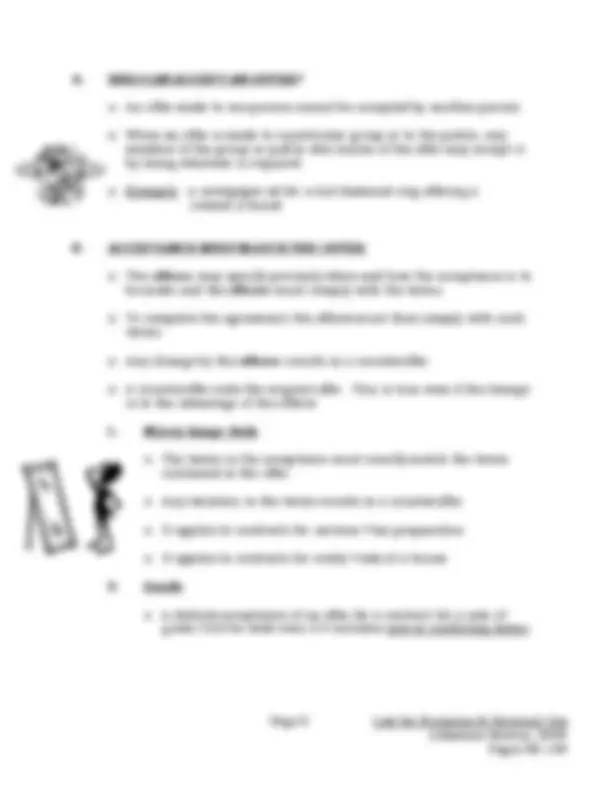








Study with the several resources on Docsity

Earn points by helping other students or get them with a premium plan


Prepare for your exams
Study with the several resources on Docsity

Earn points to download
Earn points by helping other students or get them with a premium plan
Community
Ask the community for help and clear up your study doubts
Discover the best universities in your country according to Docsity users
Free resources
Download our free guides on studying techniques, anxiety management strategies, and thesis advice from Docsity tutors
An in-depth analysis of contracts, focusing on offers, acceptances, and essential terms. It covers the six major requirements for a legally binding agreement, including offer and acceptance, genuine assent, consideration, capacity, legality, and intention. The document also discusses the importance of clear and complete offers, the role of advertisements, and the impact of revocation and modification.
What you will learn
Typology: Lecture notes
1 / 11

This page cannot be seen from the preview
Don't miss anything!







Page 1 Law for Business & Personal Use Adamson-Mietus, 2000
contract a legally binding agreement that courts will enforce.
are the basis for all economic activity between two parties.
Six major requirements that must be satisfied before the courts will treat transactions as contracts:
Terms of the offer must be accepted by the party to whom it was communicated to.
2. Genuine Assent Offer and acceptance must not be based on one party’s deceiving another, on an important mistake, or on the use of unfair pressure exerted to obtain the offer or acceptance. 3. Legality The agreement between the parties must be legal.
Example: agreeing to pay someone to commit a crime cannot be a contract
4. Consideration The agreement must involve both sides receiving something of legal value as a result of the transaction. 5. Capacity The parties must be able to contract for themselves instead of having to use a parent or legal representative. 6. W riting Some agreements have to be in writing to be fully enforceable in court.
Page 2 Law for Business & Personal Use Adamson-Mietus, 2000
offeror one who makes a definite offer.
offeree one to whom a definite offer is made.
Example: A couple want their house painted. A painter offers to do the job for $1,500 during the month of July. The owners accept the offer and promise to pay the price.
offerorthe painter
offereethe couple
offerto paint the house during the month of July for $1,
the homeowners in the above example could reject the offer by demanding a lower price or to have the job done earlier. The painter could accept or reject the counteroffer.
you need to have both an offer and acceptance to have an agreement.
offer a proposal by an offeror to do something, provided the offeree does something in return.
it can be a proposal to do or not to do some specified thing in the future.
To create a VALID OFFER:
1. Test of the Reasonable Person
The law is concerned with the appearance of a person making a so-called offer.
Page 4 Law for Business & Personal Use Adamson-Mietus, 2000
The terms have to be complete and clear in order to allow a court to determine what the parties intended and identify the parties legal rights and duties.
1. Complete
If the offer is missing essential information, then it is incomplete and legally ineffective.
All offers must identify the price, the subject matter, and the quantity.
The amount of essential information depends on how complex the transaction is.
Example: In most states the essential terms for the sale of real estate lots would include: identity of the specific lot, price, full terms for payment, date for delivery of possession, and date for delivery of the deed. If any of the terms were missing then it is not a valid offer.
Example: The Great American offers candy bars for sale. The price is identified, the subject matter is identified, and so is the quantity. This is a VALID offer.
2. Clear
Each essential term of the offer must be identified clearly.
Example of NOT clear: There is a new housing development being constructed in town. Mr. and Mrs. Drake agreed on “one lot” but they didn’t specify which lot.
3. Implied Terms
In some contracts, a term might be implied by law or common business practice.
Example: contracts between merchants for the sale of goods, when the price is not specified, the current market price is the basis for the contract.
Page 5 Law for Business & Personal Use Adamson-Mietus, 2000
4. Advertisements
Advertisements in newspapers and magazines, on radio or TV, or in catalogs or direct mailings are generally not offers.
Courts treat them as invitations to customers to make offers.
A person who advertises something for sale has a limited stock and cannot be expected to sell to the many thousands of people who might reply to the ad.
Advertisements may occasionally be offers when:
C. OFFER M UST BE COMMUNICATED TO THE OFFEREE
A person who is not the intended offeree cannot accept the offer.
A person cannot accept an offer without knowing about it.
Example: an offer of a reward that is made to certain people or to the general public cannot be accepted by someone who has never seen or heard of the offer.
Once an offer is made, it does not last forever.
A. REVOCATION BY THE OFFEROR
An offer can be revoked or modified by the offeror at any time before it has been accepted.
It is true even if the offeror said the offer would remain open for a definite longer time.
Page 7 Law for Business & Personal Use Adamson-Mietus, 2000
An offeror is not obligated to keep an offer open for a specified time even if the offeror has promised to do so because nothing has been given in exchange for the promise.
A. OPTIONS
An underlying binding contract to keep an offer open.
If the offeree gives the offeror something of value in return for a promise to keep the offer open.
The offer may not be withdrawn during the period of the option.
If the offer is accepted, the money paid for the option can be applied to the purchase price if this was agreed upon ahead of time.
Neither death nor insanity of either party terminates an option.
A binding offer by a merchant for the sale or purchase of goods stating in writing how long it is to be held open.
The Uniform Commercial Code (UCC) makes firm offers binding for the time stated, but not more than three months.
This is true even when nothing is paid by the offeree.
Neither death nor insanity of either party terminates a firm offer.
acceptance when a party to whom an offer has been made agrees to the proposal.
To create an enforceable contract, the acceptance must:
Page 8 Law for Business & Personal Use Adamson-Mietus, 2000
An offer made to one person cannot be accepted by another person.
When an offer is made to a particular group or to the public, any member of the group or public who knows of the offer may accept it by doing whatever is required.
Example: a newspaper ad for a lost diamond ring offering a reward if found
The offeror may specify precisely when and how the acceptance is to be made and the offeree must comply with the terms.
To complete the agreement, the offeree must then comply with such terms.
Any change by the offeree results in a counteroffer.
A counteroffer ends the original offer. This is true even if the change is to the advantage of the offeror.
1. M irror Image Rule
The terms in the acceptance must exactly match the terms contained in the offer.
Any variation in the terms results in a counteroffer.
It applies to contracts for servicestax preparation
It applies to contracts for realtysale of a house
2. Goods
A definite acceptance of an offer for a contract for a sale of goods CAN be valid even if it includes new or conflicting terms.
Page 10 Law for Business & Personal Use Adamson-Mietus, 2000
When the offeree has begun performance of the act requested, the offer cannot be revoked until the offeree has had a reasonable amount of time to complete performance.
3. Bilateral Acceptance
bilateral contract an agreement where both parties make a promise.
Example: a seller promises to deliver a load of stone in exchange for a homeowner’s promise to pay $
There is no agreement created in a bilateral contract until the offeree makes and communicates the requested promise to the offeror.
The offeror may state which method the offeree is to use.
If a different method is used, then it is treated as a modification of the offer.
The promise can be implied from the offeree’s conduct.
If the words used are vague about unilateral and bilateral, courts will presume that the offer is for a bilateral contract.
4. W hen Acceptance Is Effective
Offers, acceptance, rejections, revocations, and counteroffers may be communicated orally, in person, or by telephone.
Acceptance may be communicated orally, in person or by phone.
Acceptance may be communicated in writing and sent by mail, delivery service, e-mail, or fax machine.
The offeror may require the offeree to use a certain communication method.
If a different method is used, then it is treated as a modification of the offer.
Page 11 Law for Business & Personal Use Adamson-Mietus, 2000
When there is no specified or customary method for communication, most courts then say the acceptance is effective when sent by the same means used for the offer, or by faster means.
Oral acceptances are effective at the moment the words are spoken to the offeror.
Written acceptances by mail take effect when properly posted and placed under the care of the US Postal Service.
An offeror may state that acceptance doesn’t take place until it is actually received.
The UCC provides that an acceptance of an offer to buy or sell goods may be made “in any manner and by any medium reasonable in the circumstances” unless otherwise clearly “indicated by the language or circumstances.”